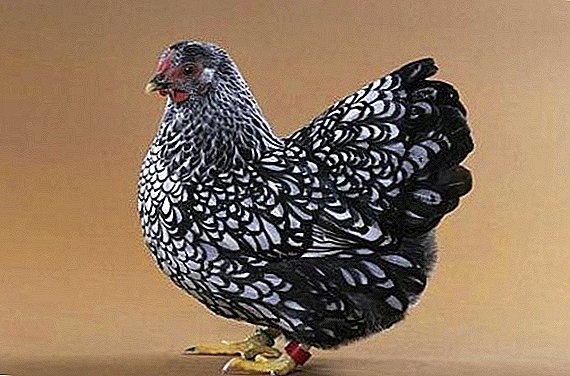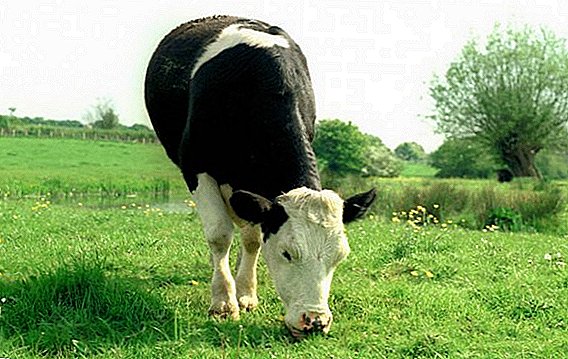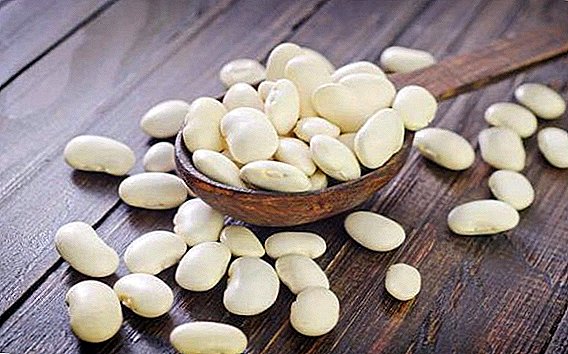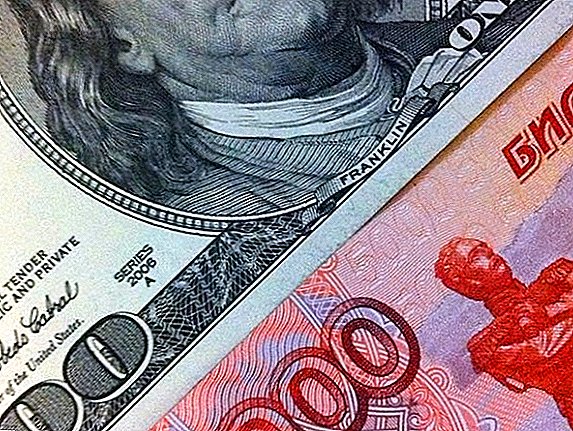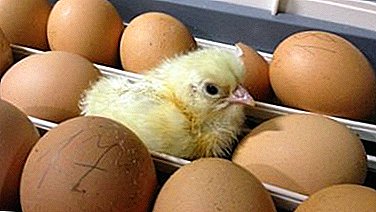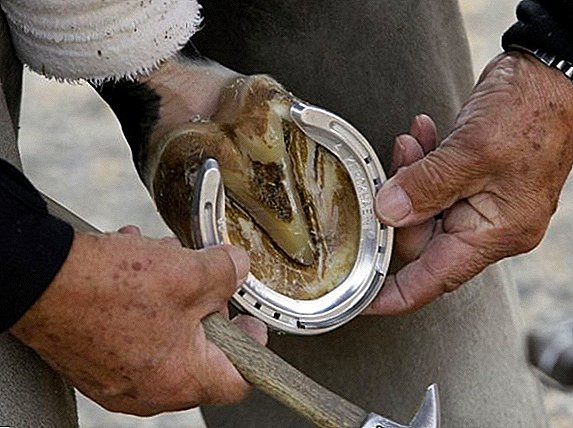 Horse hooves require regular inspection and thorough daily cleaning. These manipulations are important to prevent a number of dangerous animal diseases.
Horse hooves require regular inspection and thorough daily cleaning. These manipulations are important to prevent a number of dangerous animal diseases.
What the horse's hardened feet consist of, how to care for them and what threatens the pet if these dogmas are ignored - we'll tell you later in the article.
The structure (anatomy) of a horse’s hoof
At 3-4 months of age, the foal can begin to gradually accustom to feed the legs for inspection. Experienced horse breeders know that in order to do this, one should stroke the limb with vertical movements, then with a hand hold the ground and, with the animal’s permission, lift it to the desired height. Obedient individuals will receive a reward in the form of a delicacy, and the obstinate will receive a verbal dissatisfaction of the owner and a single whip. However, in order to understand what he saw on the horse's foot, you need to know the anatomy of the hooves of mammals.
Did you know? The ancient ancestor of horses, zebras and donkeys is Eohippus. This peaceful herbivorous animal lived on the planet long before the appearance of man. He weighed about 5 kg and did not have the strength to resist the attacking predators, so his only escape was escape. As a result, the central claws on soft paws began to harden, and the other fingers weakened. So in the process of evolution and formed the hoof.
The structure of horse hooves is identical to that of other hoofed animals of the fauna. According to zootechnicians, a horse hoof is not just a protective horn barrier, but an unusual construction consisting of several important elements.  The structure of the horse's hoof Its anatomical components are:
The structure of the horse's hoof Its anatomical components are:
- Border - located in the zone of transformation of the hairy part of the skin in the horn shoe, has the form of a small strip of width 5-6 mm, consists of a shiny and softened tubular horn. In the upper zone of the rim, hair follicles and sebaceous glands are localized. The main functionality of this hoofed component is the need to produce the outer layer of the cornea, relieving pressure on the hairy skin and its ligaments with the membrane.
- Corolla - is located a little further from the border and is characterized by a semicircular shape. Its presence is important for the depreciation of pressure and shaking when the sole is in contact with the earth's surface.
- Wall - consists of skin and cornea, which includes glaze, tubular and leaf horn. It is characterized by a special structure of the producing layer.
- Sole - has the shape of a curved plate with a small recess for the arrow. Consists of the epidermis and skin base, which its inner layer merges with the periosteum. Rapidly growing and well regenerated. The main function of this component of horse hoof is the need to protect deep-lying tissues from deformation.
- Crumb - it is localized between the turning walls, characterized by a wedge-shaped form with the apex, tending to the hook, divided by a longitudinal groove. Like the other components of the hoof, it consists of the epidermis with the stratum corneum, the base of the skin with the papillary structure and a specially formed subcutaneous layer.
Did you know? Horses, which contemporaries consider wild, in fact, are not. For example, mustangs are descendants of horses introduced to America by the Spaniards in the 16th century. The only truly never tamed species of artiodactyls are Asian wild stallions.
Hoof care
Every experienced horse breeder knows that the health of horse limbs depends a lot on the condition of their hooves, so these parts of the body require special attention. Caring for them includes:
- daily inspection;
- cleaning;
- hooking;
- lubrication with special oily agents (required only in special cases).
Every evening after the day's work, the breeder should rinse all 4 feet of his ward with running water, and then clean his horn shoe and the arrow on it from the accumulated dirt. Adult individuals will need to remove the dead part of the hoof, which will save them from Namins. This procedure is recommended to repeat with an interval of 45-50 days.  Knowledgeable owners of horse farms are advised to teach young horses, who already know how to feed a leg for inspection, to hoof hooves. Such a manipulation is very important in the care, because with the help of special equipment it allows you to remove the remains of stuck dirt and debris from the horse sole. Over time, when the young pets will be half a year old, their limbs can be taught to the knife, rasp, and other tools suitable for the treatment of dead parts.
Knowledgeable owners of horse farms are advised to teach young horses, who already know how to feed a leg for inspection, to hoof hooves. Such a manipulation is very important in the care, because with the help of special equipment it allows you to remove the remains of stuck dirt and debris from the horse sole. Over time, when the young pets will be half a year old, their limbs can be taught to the knife, rasp, and other tools suitable for the treatment of dead parts.
Important! You can not clean the mount, if he sweated heavily and soaked. First you need to wait for the complete drying of wool and leather..
In cases where the animal has a bad temper and is not accustomed to feeding the legs to care for them, veterinary tranquilizers come to the aid of horse breeders. The horse is put to sleep for a while by intravenous or intramuscular administration of "Vetrankvil" (depending on weight and age category, it is recommended to use from 5 to 10 cubic centimeters per one individual), as well as "Domosedana" (at a dosage of 1 cubic centimeters).  Once a week the horse will need to organize a thorough cleaning of its hooves with water, a hard brush and a special hook. This procedure is carried out according to the following algorithm:
Once a week the horse will need to organize a thorough cleaning of its hooves with water, a hard brush and a special hook. This procedure is carried out according to the following algorithm:
- Stand next to the animal and ask for a foot care.
- Turn around so that the horse hoof is positioned towards you with a heel.
- Gently move from the heel to the front edge of the hook remove all dirt from the horn of the shoe. Take care not to damage the shooter, otherwise the horse is threatened with lameness, as well as infection of the foot. Special attention when cleaning require turning corners and edges of horseshoes.
- After this, use a hard brush to remove any dirt and dust from horse soles.
- Lubricate the lower part of the hooves (especially in the joints with the skin layers) with a special ointment (for example, Hoof Dressing) or castor oil, which will prevent the cornea from drying out and cracking.
Important! Do not brush the horse immediately before and immediately after feeding..In addition to everyday cleaning, do not forget to inspect the horse's feet every time for signs of pathology. In cases where creases are found, they are recommended to gash with a rasp or cut with a sharp knife.
Trimming and trimming
Long wearing horseshoes and walking on a hard surface are the main reasons for the wear of a dead horse shoe, the appearance of cracks in it and the accumulation of pathogenic microflora. Consequently, in order to prevent various diseases of the legs of the ward of the mount, the breeder will need to periodically trim hoofs and change horseshoes.  For this you need:
For this you need:
- Carefully remove the worn old horseshoes and cut out the horn with a hoofed knife. This procedure is done very carefully, because even the slightest damage to sensitive soft tissues can permanently knock an animal out of the work schedule. Require special attention to flat soles.
- After that, you can proceed to the clearing of the cornified foot zone and its furrows. The manipulation is carried out with a special knife or rasp.
- With cleaned and trimmed limbs take measurements for the manufacture of new horseshoes. According to experienced breeders, these horse attributes must correspond to the size of the hoof and properly bend around them.
- Only after that you can shoe your horse.
Video: Horse hoof trimming
Forging horses of any age is shown in a month and a half. This requirement is due to the impossibility of stretching the hoof part with the constant wearing of horseshoes. The fact is that when walking, when pressing the weight of a horse’s body on a limb, blood with a special force comes to the legs, distributing nutrients in soft tissues.
Important! Veterinarians argue that for the formation of healthy hoofs in horses it is necessary to optimally distribute the load, as well as timely trimming of the stratum corneum. The correct cornea is characterized by a thin even layer of a neat covering, a concave foot, a well-developed horn arrow, pointed edges, a rounded crumb of a regular shape with a smooth transition to the rounded edge of the corolla and the absence of various cracks, dimples and crevices.
Horseshoe prevents the opening of the hoof, which provokes blood stasis and weakening of the nutrition of the extremities. Continuous wearing of horseshoes, according to experts, is very detrimental to the health of these animals, because they are too dependent on movement. 
Horse hoof diseases
On a healthy hoof, it is impossible to notice the curvatures of the heel corners, discrepancies at the site of attachment of the walls to the sole, holes and depressions in the cornea, as well as Naminov, which are blue-red or yellowish spots.
Untimely and improper care, as well as its complete absence, contribute to the development of a pathogenic environment, which soon ends with the progression of dangerous diseases of horse hooves. Consider the main threats to them.
Did you know? The saying, “Don't take a look at the gift horse in the mouth” says that it is not customary to discuss gifts. This idea was voiced by Christian theologian Eusebius Sophronius Jerome in the 4th century.
Rheumatic inflammation
The disease is characterized by acute and chronic course, often develops on both forelimbs, less often affects the pelvic or all 4 of the foot. It proceeds as aseptic serous inflammation of the base of the skin, the hitch part of the wall and the sole of the hoof.
The occurrence of rheumatic inflammation associated with:
- long hard work;
- burden hooves during long shipments;
- abundant feeding of animal concentrates;
- rapid cooling of heated horses;
- infection;
- tendency of the horse's organism to allergic reactions;
- various hoof deformations.
 Clinical signs of inflammatory processes are:
Clinical signs of inflammatory processes are:
- rapid pulse;
- increased breathing;
- body temperature increased to +41 ° С;
- burden of the back of the hoof (if chest extremities are affected);
- pain when squeezing the front parts of the inflamed feet;
- the lethargy of the animal (the horse reluctantly pulls away, making short, tangled steps);
- lameness, which may subside in the period of long walking, but after a short rest will certainly increase;
- lying down and the complete lack of desire for any movement (appears with the defeat of all limbs);
- setting all legs forward;
- excessive sweating;
- muscle tremor;
- tension when walking;
- displacement of the hoof bone (occurs only in chronic cases);
- development of urchin hoof and purulent poddermatit.
Did you know? The average duration of horse life is about 25-30 years. However, there is written evidence that the England-born stallion Old Billy lived for 62 years. Experts say that the first horse year can be compared with 12 human years. The next year is compared with the human seven-year-old, and the next 3 years are equal to another 12. Thus, when recalculating the years lived by the English old-timer, it turns out that he lived for 173.5 years.Rheumatic hoof inflammation is treated by dehydrating the body and reducing the amount of exudate. For this purpose, for the first 3 days, the animal is placed in wet and cold clay or running water.
 The position of the horse's limbs with rheumatic hoof inflammation. After this, they introduce:
The position of the horse's limbs with rheumatic hoof inflammation. After this, they introduce:- saliva drugs: "Polycaprin" or "Arecoline" - subcutaneously, the dosage is calculated according to the recommendations of the manufacturer;
- 10% sodium salicylate solution - a single injection is 200 ml;
- drugs with a laxative effect;
- 0.5% solution of Novocain - anesthetic blockade is relevant in the area of the tarsus, the administered dose of the drug should not exceed 100 ml, intravenous injections are shown daily for 3-4 days;
- 0.1% adrenaline solution - at a dosage of 5-6 ml daily for 5-7 days;
- 10% solution of calcium chloride - 200-300 ml daily for 5-7 days;
- "Hydrocortisone" - intravenously in 5 ml per individual;
- "Butadion" - orally in 8-10 g.
Did you know? The Hindus associated the horse with the cosmos, and the white horse was revered as the last incarnation of the god Vishnu.
Corolla cellulitis
The causes of this disease are:
 Cellulum in the corolla area
Cellulum in the corolla area
- advanced forms of deep infected serifs;
- direct forging;
- deep purulent pododermatitis;
- purulent inflammation of the hoof;
- development of subtrochleitis.
Phlegmon ungulate corolla is manifested by the following symptoms:
- soreness of the cornified parts of the limbs;
- the intensity of the animal;
- swelling of the corolla area (may be bright or mild);
- overhanging parts of the body above the hoofed wall;
- strong limping;
- fluctuation (appears in the stage of abscess formation);
- increased overall body temperature;
- lack of appetite;
- depression.
- alcohol-ichthyol dressings or 20% solution of camphor alcohol (externally);
- 0.5% solution of "Novocain" - administered intravenously at a dosage of 100 ml;
- "Penicillin" - intravenous 5 cubes;
- 40% solution of "Hexamethylenetetramine" ("Urotropin") - the veterinarian should appoint an injection dosage, depending on the horse's age and its state of health.
Did you know? Horses are able to discern the emotions in the human voice.
Notch corolla
The occurrence of corolla wounds is due to mechanical injuries that are formed during prolonged contact with a horseshoe or when the legs are not correctly set. The causes of the disease are also:
- started forging;
- long movement on an uneven slippery surface;
- sharp settling down;
- Steep high-speed turns.
 You can find out the disease by the following features:
You can find out the disease by the following features:
- the presence of deep or superficial wounds;
- abrasions on the skin;
- bleeding (most often minor);
- strong lameness (happens only with deep serifs);
- soft tissue swelling on the foot;
- sore feeling when touching corolla;
- crush tissue.
If you do nothing, waiting for self-healing, the illness will soon develop into a phlegmon.
Did you know? Horses love music and have a selective taste. They prefer soothing or inspiring instrumental compositions and are annoyed with loud rock.
The corolla serif treatment is reduced to cutting out hair on the affected areas and treating wounds with a 5% iodine solution or 2% alcohol solution of pyoctanine, after which a bandage can be applied.
 Deep wounds are treated with surgical techniques. After the procedure, they are necessarily sprinkled with a mixture of iodoform and boric acid (in a ratio of 1: 9) or a finely chopped tablet "Streptotsid" or "Penicillin".
Deep wounds are treated with surgical techniques. After the procedure, they are necessarily sprinkled with a mixture of iodoform and boric acid (in a ratio of 1: 9) or a finely chopped tablet "Streptotsid" or "Penicillin".
The festering serifs are treated with dressings with camphor spirit or Vishnevsky ointment, alcohol warming compresses. In the presence of swelling required trimming of the cornea from the side of the corolla. This is done very carefully, so as not to hurt the affected skin.
Read more about the structure and diseases of the limbs of horses.
Necrosis of the hoof cartilage
This disease is a complication of the coronet wounds of the hoof. In addition, the reasons for its formation are:
- direct forging;
- deep purulent pododermatitis;
- mechanical damage arrows.
- pronounced limp;
- presence of local phlegmon;
- abscesses that open up arbitrarily;
- fistulas, from which purulent exudate is released (may heal, giving way to new formations);
- roughness of cartilage tissue, which leads to its complete destruction (visible only when probing).
 Treatment of necrotic pathology of ungulate cartilage is as follows:
Treatment of necrotic pathology of ungulate cartilage is as follows:
- the introduction into the channel of the fistula 25-30% solution of copper or zinc vitriol;
- scraping the walls and bottom of the fistula with a sharp spoon;
- dissecting tortuous fistulas and removing necrotic tissue from their cavities;
- the treatment of wounds with antiseptic preparations and the imposition of suction dressings.
Important! As a result of deformed horse hooves, corpuscular muscle groups develop incorrectly. Animals suffering from this problem have a very thick "lumpy" neck, and there are also no indentations in front of the shoulder blade.
Poddermatit
This is an inflammation of the base of the hoofed skin, which can be aseptic or purulent. The causes of the disease are:
- movement of a relaxed horse on a hard surface;
- incorrect device horseshoe;
- poor cleaning of the sole;
- impairment of hard objects between the horseshoe and the sole of the hoof;
- Namins;
- corneal deformity;
- violation of the integrity of the horn shoe with subsequent infection.
 Pododermatitis accompanied by the following symptoms:
Pododermatitis accompanied by the following symptoms:
- limping;
- soreness (in cases of suppuration it is sharp, it is palpable using pressure with forceps or percussion);
- the presence of dark red or yellow areas on the sole;
- signs of hemorrhage;
- setting the sore limb forward (occurs when the animal is at rest);
- frequent flexion of the injured leg;
- increased heart rate;
- the presence of dark gray or white-yellow purulent discharge (with deep forms, thick pus is released through the oval opening);
- corneal detachment from the producing layer;
- fever;
- rapid breathing.
Important! When the weight of the horse puts pressure on the hoof, the blood from it is forced up through the veins. Thus, the hoof plays the role of a circulation pump.
Treatment of the disease begins with the elimination of its causes. When aseptic forms recommended:
- Organize local cold (sore feet of an animal are placed in cold water or wet clay).
- 3 days after that, veterinarians recommend starting thermal procedures, which are baths with hypertonic solutions with a temperature of + 40-42 ° C, as well as hot clay.
- When the horse is no longer limping, it is healed by a medical forging with a pad of felt, leather or with a removable metal bottom.
Video: How to treat purulent pododermatitis
Purulent poddermatitis require more attention and effort. Their therapy includes:
- the build;
- contracture (incision) from the foot;
- removal of purulent discharge and exfoliated skin;
- foot baths in a 3% solution of creolin with a temperature of + 39-41 ° С;
- irrigation of the exposed skin base with 3% hydrogen peroxide solution;
- dressing with turpentine, birch tar or Vishnevsky ointment.
Find out how much an adult horse weighs on average.
Rotting arrows
The disease is a chronic inflammatory process with the formation of pus that provokes the destruction of the hoof arrow. The site of its localization is the calcaneal contraction of the pelvic legs, less often - all 4 hooves.
The reasons for the disease experts call:
- unsanitary conditions when keeping animals;
- lack of care for their limbs;
- lack of mobility.
 It is easy to recognize the decay of arrows in horses by the following features:
It is easy to recognize the decay of arrows in horses by the following features:
- corneal destruction;
- the release of fetid exudate;
- enlarged papillae;
- limping when moving on soft soil.
Did you know? Some horses have the ability to open the doors to their brethren and set them free.Therapeutic measures include the removal of exfoliated parts of the arrow and the application of medicines:
- 8-10% copper sulphate solution (a tampon is impregnated with medicine and applied to the affected area);
- birch tar or turpentine (used for dressings).
Cancer arrows
The disease is also called chronic verrucous pododermatitis. Causes of occurrence are:
- gross violations in keeping animals;
- lack of care or illiterate conduct;
- prolonged corneal maceration;
- sedentary lifestyle;
- purulent infection of the arrow;
- violation of lymphatic drainage in the distal extremity;
- defective feeding.
 The progression of carcinogenic substances in the horse's horn shoe is manifested by clear symptoms:
The progression of carcinogenic substances in the horse's horn shoe is manifested by clear symptoms:
- limping;
- destruction of the cornea in the side of the arrow and interfacular grooves;
- the presence of fetid exudate;
- warty growth of the papillary layer of the base of the skin, which is characterized by gray-red and bluish-red hues (resembles cauliflower in appearance).
After treatment with drugs, a plaster-free ligation is applied to the wound. When the affected part of the foot is covered with a young cornea, the horse can be shackled with horseshoes with a metal bottom and a gasket soaked with tar. It is recommended that the sick animal not be loaded and walk daily on a soft primer.
Did you know? In the United States, there is a law that prohibits unmarried women from riding horses on a Sunday. Violators of this norm face jail. And in some states, a new husband cannot ride a horse alone, until he has been married for more than a year.As you can see, horse hooves require special attention and care. Without proper care, they are subject to serious illnesses that can even be fatal for your ward. Every conscious horse breeder should daily inspect and clean the hooves of his horse, which is the key to a healthy and long life of the ward.



